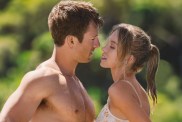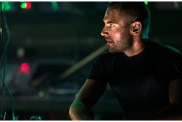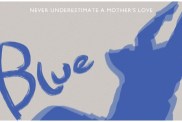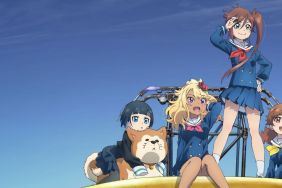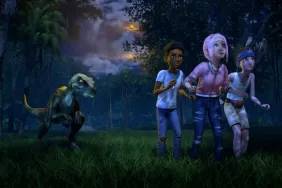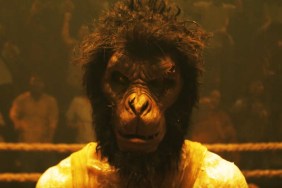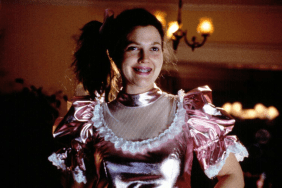ComingSoon.net was recently invited out to spend time on the campus grounds of Industrial Light & Magic (ILM) and talk with visual effects supervisor John Knoll, as well as animation supervisor Hal Hickel. They were kind enough to sit us down and explain the progression in approach and technique utilized in the development of the “Pirates of the Caribbean” movies. They explained a bit about the processes involved from Pirates’ 1 and 2, and also gave us a little info about Pirates of the Caribbean: At World’s End.
We were shuffled into a viewing theatre that was used to watch dailies and were treated to some of the coolest special effects sequences out there right now. After that John Knoll, who has been with ILM since 1986, and has been nominated and won both American and British Academy Awards for films like “Star Wars” Episodes I, II and III and of course “Pirates of the Caribbean,” introduced himself and began to fill us in on some of the interesting details about working on “Pirates of the Caribbean.”
When asked about his feelings toward Pirates of the Caribbean: The Curse of the Black Pearl, Knoll explained, “It was a little different than projects I worked on previously, I really loved the idea of these characters that as they passed through the moon light they become skeletons.”
He took time to explain the finer points of working alongside the traditional filmmaking personnel, “I have a philosophy that the visual effects can’t control the production process, we have to be as friendly to the filmmakers as possible and place as few constraints on the shooting as we can.”
When faced with the task of making the film look as seamless as possible, with smooth transitions between the live action and the special effects, the team decided on a very unique approach. “The only sensible way to shoot this [“Pirates” 1] was to shoot it like it was live action. We’ll shoot it with the characters, then we’ll get a clean plate to help us paint out the live action character when he’s CG (computer generated), the rest is kind of hand matching, we’ll match the performances as closely as we can, and we’ll make these transitions as seamless as we can make them. A lot of good things came from that, shooting it on set like any other live action, you got the benefit of the director being able to work with the actors in the way he’s used to working, and the actors being able to play their performances off each other in a way their used to doing. The director of photography has someone to light, just like you see us do, the operator has someone to frame up on, all these things combine to give the exact same energy, the same vibe as all the rest of the movie, and there’s no stylistic difference when you go into the visual effect scenes, it just sorta happens.”
Knoll went on to elaborate on the complexity of the visual effects process. “So often when you’re doing visual effects, it’s a very complex process, it’s expensive and because of that it’s often very carefully planned, the angles are all very carefully storyboarded and thought out and then you might try and shoot just those pieces so you’re as efficient as you can and there’s

frequently a stylistic change when you get to those scene you just feel that there’s something more deliberate and planned about it and the shooting methodology just gave us this nice just seamless thing where it fit into the rest of the movie.”
From there the conversation moved away from the first “Pirates” movie and on to the second where the team faced new challenges, and new goals. With the success of the first movie, the pressure was most assuredly on to make lightning strike twice. You would never imagine this to be the case in meeting either John Knoll or Hal Hickel. In talking about these films they seemed more like two dads that had just watched their kids playing on the swings. They were the very definition of ‘making it look easy.’ Not to worry, Knoll explained that easy wasn’t really part of the equation.
Knoll started of this segment of the discussion by explaining the new challenges that Pirates of the Caribbean: Dead Man’s Chest faced he and his staff with. “[With “Pirates” 2] we have this new challenge where the characters where fully CG all the way through, so they didn’t need to make the transitions, but we were pretty happy with the production methodology of just shooting on set like it was all live action and [we’d] figure out how to make that all work because it has all these benefits that were previously mentioned by Hal that if they don’t have any transitions, then can we dress them in something that lets us match the animations more faithfully, [it will] let us get a more accurate representation of what they were doing on set.”
He then stopped to reflect on some of the issues that faced them on the first film and the differences on “Pirates” 2. “We have this issue on ‘Pirates’ 1 that we were just matching by eye, and we have all these characters with these long flowing cloaks, that to some extent make it harder to see where all the joint positions really are, it’s a little ambiguous and some dramatic lighting that sometimes had lights and shadows so you weren’t quite sure what was going on there.”
Knoll then explained the strategy that was employed for correcting some of these issues in the second film. He also explained the prerequisites that their planning had to meet. “[We considered] what could we do to match that stuff better, so we could get a higher quality performance out of it. So we got together with R&D about [doing] something that would get us ideally what we could get out of a full on motion capture session, but it’s gotta be something we can do the same way we did before, it’s got to be on set, can’t be anything that slows down the production, can’t put any constraints on the shooting. We can’t say for example, that you [the film team] can’t use steady cam, can’t use hand held cameras, it can’t be any of those kind of constraints, we can’t have anything that takes a long time to set up, we have to be able to get on set and shoot with it. There can’t be any restrictions as far as lighting or what sort of weather conditions this happens under.”

This was easier said than done. The script itself also posed problems that Knoll and his team would have to address. “Reading in the script we realized that these characters would be standing knee deep in a lagoon in Zuma and the jungle in Dominica, we’re going to be on the deck of a ship, we’ll be out on the ocean with pouring rain, so whatever we came up with had to be indestructible, it had to be robust and able to take that kind of abuse.”
We were then told about the device that was developed to aid the effects team in their efforts to provide the highest quality visual effects possible. Knoll, “So, R&D scratched their heads for a little bit and came back with this idea of the Imo-Cam, it’s the stuff with the guys in the grey suits. They’re wearing relatively tight fitting suits, so that we can clearly see where the body is, and we have a series of markers that help us determine exactly where the joint positions are. In the end we get the equivalent of what we get on a motion capture stage but without all the junk that goes along with it. I think that translated pretty directly and we got some good performances.”
With that Knoll gave the floor to animation supervisor Hal Hinkel, who had begun his career at ILM as an animator for The Lost World: Jurassic Park, and has worked on films like “Star Wars” Episodes I & II, A.I. Artificial Intelligence, Dreamcatcher, and both previous “Pirates” movies. He started by talking about some of his favorite aspects of working on “Pirates,” as well what matters most to him as an animator. “One of the things that’s been really cool for me, from an animation stand point over all three of these films, [I’m not one of those people who are dying to do a super photo-realistic human being in a movie, it’s just not interesting at all for me], I really like to create things that couldn’t possibly be real, but then we try to make them look as real as possible, that’s just more interesting for me. But frequently that’s creatures that are twenty feet high or two feet tall, what was fun in these movies is that the creatures we were doing, whether it be the skeleton in one or Davy Jones’ crew in two and three, they’re all human size, human scale characters, they’re human beings but they’re hideously mutated either by the Aztec curse or being on Davy’s ship too long and the design challenges were really unique and interesting.”
His take on movie making and how things should be done was fascinating, as he explained his desire to create a certain type of reaction from the audience. “Because you want to push the design to the point where the audience doesn’t say, ‘well that’s just a guy in make-up.’ You know if you’ve done your job right, but at the same time you don’t want it to be so out there that they just kind of look at it and say, ‘well that’s just CG.’ And even if the audience looks at something and says, ‘That’s great CG.’ To me, that’s a little bit of a failure, you kind of want them to be confused by what they’re seeing and not quite get what you’ve put in front of them, that’s much more interesting for the audience and a lot more fun for us. So that was really cool for these films both for the skeleton characters, making Barbossa’s skeleton self really look and feel like Geoffrey Rush and the same with Johnny Depp and Captain Jack’s skeleton really felt like him, so that the audience’s reaction wasn’t to say, ‘Oh, look at the cool CG skeleton,’ but

instead to say, ‘Wow, look what they did to Geoffrey Rush!’ Which I think is a completely different reaction and a much better one, likewise for Davy Jones and his crew is a little different because you don’t see the transition from Bill Nighy to Davy Jones, because he’s always Davy Jones but we really wanted people to look at the character and again, not look at it and say, ‘Wow that’s some great CG,’ but instead go, ‘Whoa, is that a guy in make-up, wow, but those tentacles couldn’t be make-up, are they animatronics, well maybe that’s CG,’ and be completely mixed up, and hopefully just let loose of it and just accept the character if we did our job right.
When it came time to talk about particulars of “Pirates” 3, Knoll talked about how much all their previous work from the first two movies made it possible for them to complete the third installment in the time that they did. “We couldn’t have finished [the movie] if we couldn’t share the assets, and even some of the renders from shot to shot, with some of the stuff on deck, what’s really happening is that it’s all about the stuff in the foreground, and you want believable looking water in the background even if it’s not what the shot’s about.”
What they had shown us in reference to “Pirates” 3 were some clips from the final scene in the movie referred as ‘The Maelstrom.’ In the scene, we see Captain Jack locked in combat with Davy Jones while the ship is rocked on ravaging waves, leading towards a giant whirlpool. They couldn’t divulge too much info on the newest of the films but Knoll did have this to say. “Almost every show we do there’s a development process where you kinda figure out what you’re doing and work out the technical hurdles and get to a point where everything’s running smoothly. Now that’s usually towards the final weeks of the show, you finally have like all the bugs worked out and your machine is efficient and then the show’s over, you don’t get to reap the benefits of it, you struggled the whole way, and finally you got it working in time for the end. About six weeks ago, we finally had everything working and now the show’s over. It’s actually a very rare pleasure to now immediately go into another production where we have a bunch of the same characters and now, you know what the crew is all really good at it and it all proceeded very smoothly. We went into three and on one hand we had a body of work that is Davy and his crew, we had that story to wrap-up, and then there were entirely new challenges that we had to deal with, well [put it this way] I’ve met some very long hours in the last few months, at this very moment we still have six shots that we’re struggling with and hopefully have done later today.”
What we saw that day was only a glimpse of the work involved to make movies like “Pirates of the Caribbean”; words can never describe the amount of effort that goes into the production of what have been some of the best movies of our time.
Click here for many more creature and effects shots! Pirates of the Caribbean: At World’s End is now playing worldwide.
